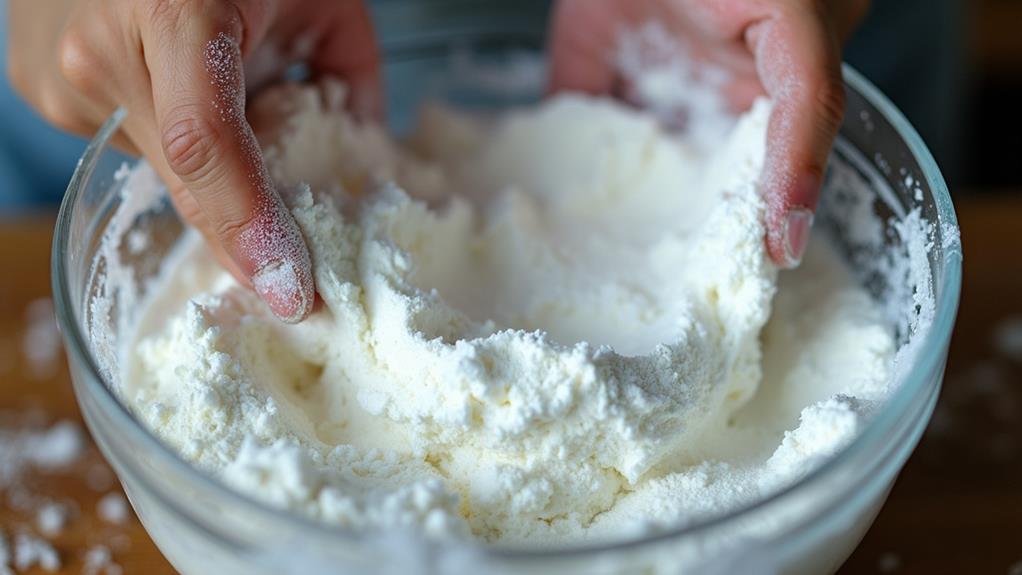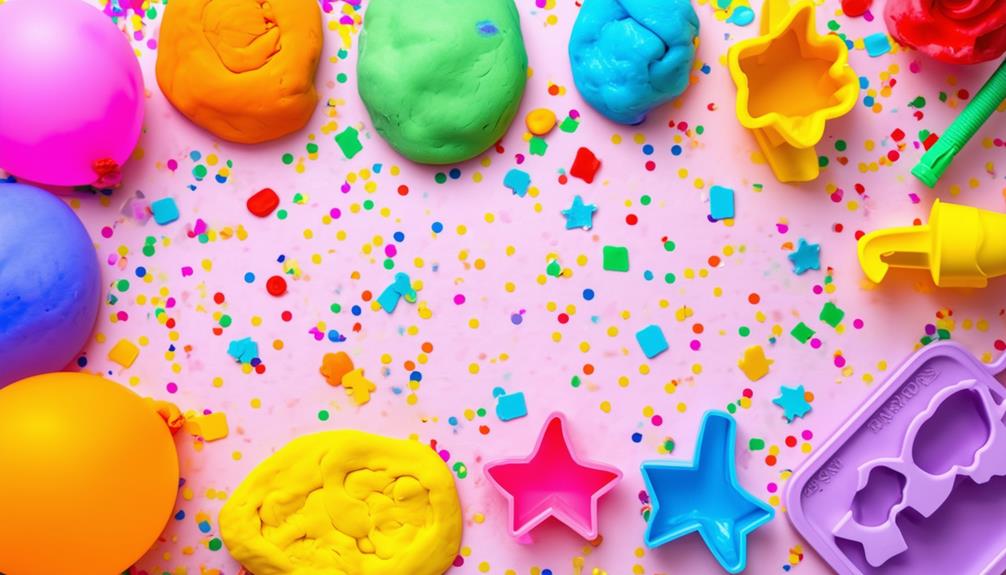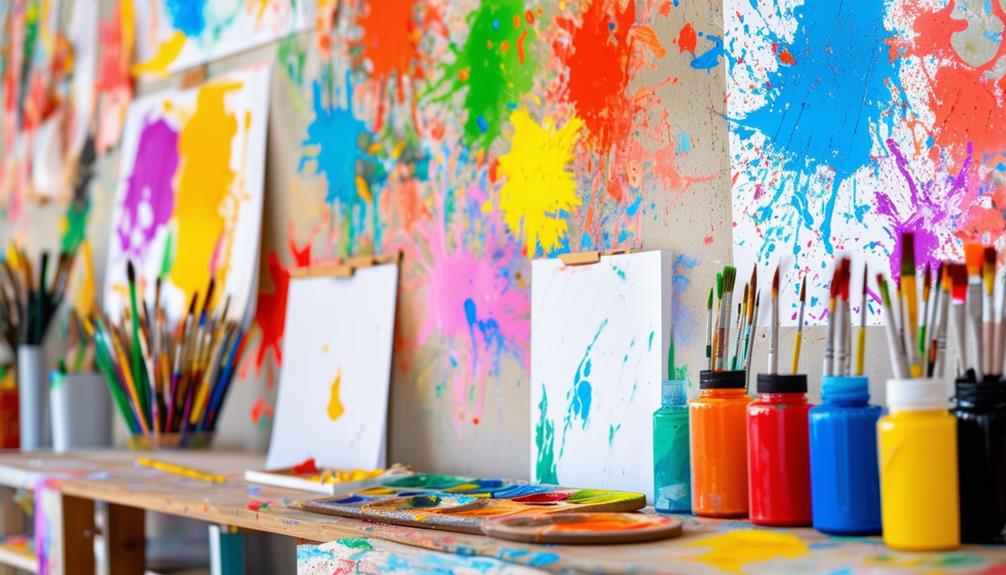What Kind of Clay Is Best for Kids?
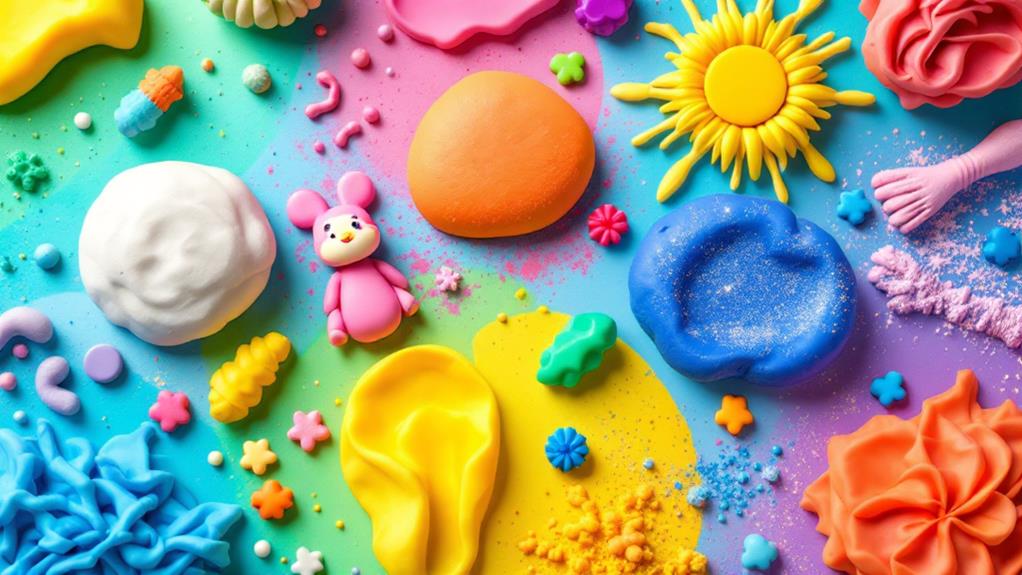
When choosing clay for kids, prioritize safety and ease of use. Go for options like Play Dough, which is soft and perfect for young hands. Air-dry clay works great for different projects since it hardens without needing a kiln. If you have older children, consider polymer clay for more intricate creations, but it does require baking. Look for non-toxic, water-based clays labeled safe for kids to guarantee a healthy crafting experience. Remember, selecting the right clay boosts creativity and fun, so stick around to uncover more exciting options and techniques to investigate!
Types of Clay for Kids
With regards to creativity, choosing the right type of clay for kids can make all the difference. If you're looking for something soft and lively, Play Dough is a fantastic choice. It's pliable and encourages fine motor skill development, making it perfect for little hands. Furthermore, it provides engaging sensory experiences that stimulate tactile discovery and body awareness. For projects that need to harden without a kiln, Air Dry Clay is user-friendly and allows kids to create confidently with their imagination.
If your child is a bit older and ready for more advanced projects, Polymer Clay, like Sculpey, is ideal. Its firm texture holds intricate details well, but remember, it requires baking to harden. On the other hand, if you're after a lightweight and mess-free option, Model Magic is great. It air-dries and makes crafting enjoyable without the hassle of cleanup or baking.
Always opt for Non-Toxic Modeling materials, like water-based and dough clays, to guarantee your child's safety while they investigate their creativity. With these options, you can help foster a love for art and self-expression in your kids while keeping their well-being in mind.
Benefits of Clay Play
Selecting the right clay for children opens up a realm of imaginative possibilities, and the advantages of engaging with clay play are numerous. To begin with, clay play improves fine motor skills as your child manipulates and shapes the material, enhancing their dexterity and hand-eye coordination. This hands-on activity provides a therapeutic sensory experience, allowing kids to express their creativity while relieving stress and promoting mindfulness. Furthermore, engaging in clay play can improve fine motor skills through molding and shaping activities, which are vital for developing the small hand muscles necessary for tasks like writing and dressing.
Using air-dry clays makes it user-friendly and accessible for children of all backgrounds, encouraging independent exploration without the need for baking. As your child works with clay, they'll naturally develop problem-solving skills, learning to navigate challenges during the creation process and refining their artistic ideas.
In addition, the tactile nature of clay play stimulates sensory development, helping children understand texture, form, and spatial relationships. Through this engaging activity, they not only create but also gain critical skills that support their comprehensive growth. So, when you choose clay for kids, you're investing in a multifaceted experience that nurtures creativity and development in a fun and meaningful way.
Health Risks of Toxic Clays
Many parents may not realize that some clays marketed for kids can pose significant health risks. Toxic clays, particularly those made from polymer materials, often contain harmful substances like dioxin and phthalates. Dioxin, a known carcinogen, is released during the production and disposal of PVC-based products, threatening both human health and the environment. Phthalates, frequently found in these clays, have been linked to developmental disorders in children, including attention disorders and autism.
Given that children are especially vulnerable to the adverse effects of toxic clays, it's essential for you to be informed about the products you choose for their crafting activities. Awareness of the health risks associated with specific brands and types of modeling clay can empower you to make safer choices. Opting for non-toxic alternatives guarantees that your child's creative playtime is enjoyable without compromising their well-being. Always check labels and research brands to find clays that are safe for children. By prioritizing non-toxic options, you can help protect your child from potential harm while fostering their creativity and imagination.
Safe Clay Options
When it comes to selecting clay for your kids, safety is paramount. You'll want to focus on safe clay options that are non-toxic and easy for children to use. Water-based clays are a fantastic choice; they're non-toxic, environmentally friendly, and provide a smooth texture that young artists love. Plus, they're easy to clean up!
Another great option is dough clays, made from flour and cornstarch. These are safe for most kids unless they have gluten allergies, and they're simple to mold and shape. For a more versatile experience, consider oil-based clays. They don't stick to surfaces and are reusable, making them ideal for creative play without health concerns.
Brands like Sculpey and Craft Smart Plastalina offer multiple safe clay options specifically formulated for children. When shopping, always look for clays that carry non-toxic certifications from organizations like the Art & Creative Materials Institute. This guarantees that you're providing a safe crafting experience for your kids, allowing them to express their creativity without any worries. Remember, prioritizing safety will help foster your child's love for art and crafting!
Choosing the Right Clay

What type of clay will best suit your child's creative needs? When selecting the right clay for kids, consider their stage and interests. For younger children, Play Dough is a fantastic option. Its soft texture and lively colors make it easy to mold, ensuring safe and enjoyable play. If your child is ready for a project that hardens, Air-Dry Clay is an excellent choice. It doesn't require baking and is perfect for different arts and crafts.
For a more mess-free experience, you might opt for Dough Clays made from flour and cornstarch, which are safe unless there are gluten allergies. If you want something reusable, Oil-Based Clays are ideal as they remain workable without drying out, allowing your kids to shape their creations repeatedly.
However, if your child is older and enthusiastic for more intricate projects, consider Polymer Clays. They offer lively colors but require adult supervision for baking. Choosing the right clay can inspire creativity and provide endless opportunities for imaginative play.
Safety Tips for Clay Use
When working with clay, ensuring safety should always be a top priority. Start by selecting clays labeled as non-toxic, avoiding harmful substances like PVC, dioxins, and phthalates. Look for products certified by the Art & Creative Materials Institute, ensuring they meet safety standards tailored for kids.
Carefully read labels to find biodegradable and gluten-free options, specifically designed for children to minimize health risks. Always supervise children during clay activities to prevent ingestion of materials and to encourage safe handling practices.
After the fun is done, it's essential to clean tools and surfaces thoroughly to avoid any potential contamination from clay remnants. Properly cleaning your tools not only keeps your workspace safe but also maintains the quality of the clay for future use.
Getting Started With Clay
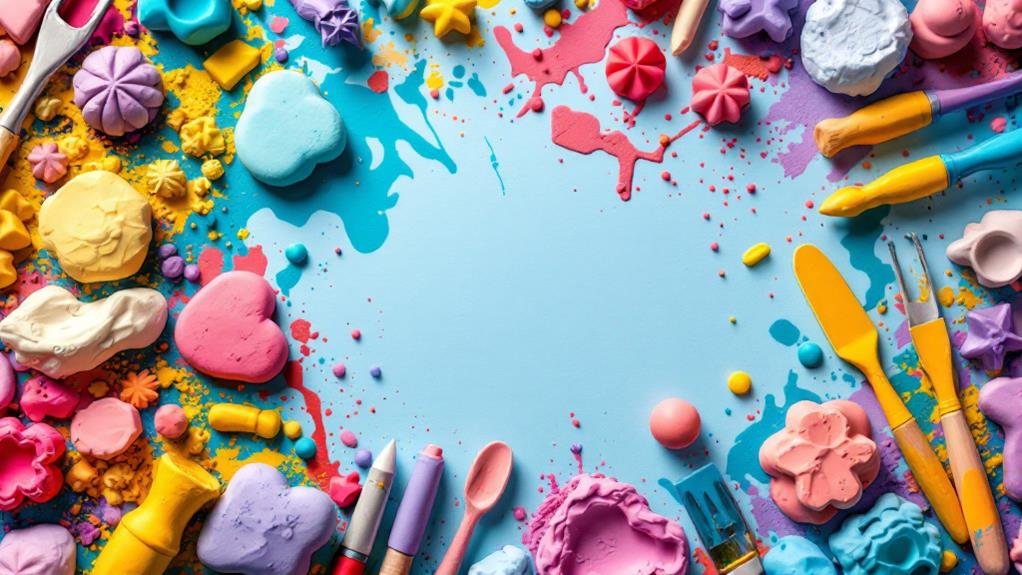
Starting with clay can be an exciting adventure for kids, providing endless opportunities for creativity and expression. To kick things off, designate a safe and comfortable workspace that's easy to clean up. This setup will encourage your little artists to engage in their clay projects without stress.
Begin with non-toxic and child-friendly options like air-dry clay or Play-Doh. These materials are soft and pliable, making them perfect for young hands. Gather some basic modeling tools, such as rolling pins, shaping tools, and cookie cutters. These tools will improve the clay play experience and allow your kids to investigate their creativity further.
Start with simple projects like basic shapes and pinch pots to build confidence and foundational skills. As they create, remind them to follow the manufacturer's guidelines for drying methods and storage to guarantee their creations last. Encouraging proper care will help your kids appreciate their art even more. With the right materials and a supportive environment, you'll set the stage for endless clay adventures that inspire imagination and skill development!
Simple Clay Projects
There's a world of fun waiting for kids with simple clay projects that spark creativity and build fundamental skills. Start by introducing basic shapes like balls, snakes, and squares using safe, non-toxic options like Play-Doh or air-dry clay. These simple forms help children gain confidence before moving on to more intricate creations, such as pinch pots and coil projects.
Encourage free-form creations, letting kids investigate their imagination without strict guidelines. This creative play allows them to express their artistic abilities while enjoying the process. You can also incorporate natural clay for a different tactile experience.
For school projects or just for fun, consider adding finishing touches like paint, markers, or glitter to improve their clay items. These details make their creations even more visually appealing and personal.
Always verify the projects are suitable for their developmental stage, and supervise your little artists during their creative play to promote safety and teamwork. By guiding them through simple clay projects, you'll help them develop crucial skills while having a blast with their artistic endeavors!
Intermediate and Advanced Techniques
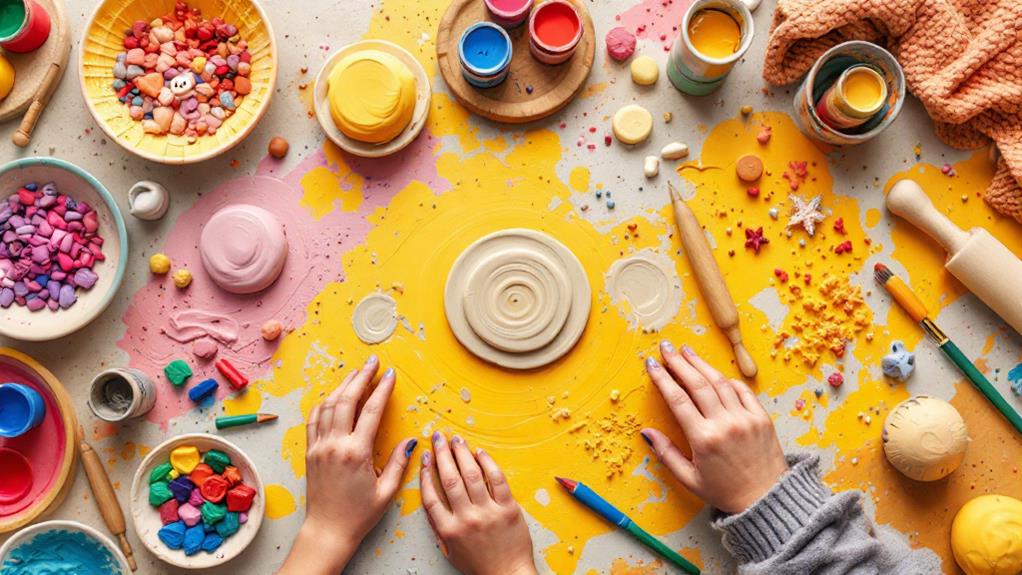
Many kids are ready to take their clay skills to the next tier with intermediate and advanced techniques that foster creativity and precision. Using polymer clays for detailed sculpting is a great starting point. This technique requires baking to harden the clay, allowing for intricate designs with lively colors and finishes. As you grow more confident, you can investigate advanced techniques, like incorporating mixed media. Adding found objects or paints can improve your polymer and air-dry creations, resulting in multi-dimensional art pieces.
If you're working with water-based clays, practice advanced hand-building methods like coiling or slab building to create larger, more complex structures. You can also introduce specialized tools, such as pottery wheels or sculpting tools, to refine shapes and textures, which will greatly boost the quality of your work.
Don't forget to utilize resources like online tutorials or local workshops; they can provide valuable guidance on advanced techniques and encourage your artistic journey. These resources will help you master new skills and inspire you to create unique clay masterpieces!
Caring for Clay Creations
Caring for your clay creations is crucial to keep them looking their best and lasting for years to come. Start by following the manufacturer's guidelines for drying, baking, or air-drying to prevent damage. If you're working with air-dry clay, always store creations in airtight containers. This practice helps prevent them from drying out or cracking over time.
It's also important to regularly dust off your clay items with a soft cloth. This simple step keeps them clean and maintains their appearance. Be cautious about exposing your clay creations to excessive moisture or heat, as these conditions can lead to warping or deterioration.
If you notice cracks or chips, don't panic! You can use repair techniques such as a small amount of water or extra clay to restore the integrity of your piece. By taking these steps in caring for clay creations, you'll guarantee they remain beautiful and cherished for years to come. Remember, proper care can make all the difference in preserving the hard work and creativity you've put into your projects!

